Suggested Learning Intentions
- To multiply two-digit numbers by partitioning them into smaller numbers, using a visual model as a support
Sample Success Criteria
- I can partition two-digit numbers
- I can use grids or arrays to help solve a multiplication problem
- I can model and explain my thinking using manipulatives
This stage has been inspired by the Multiplication in a Table Format problem on Maths300, and is reproduced with permission. Access to the problem on Maths300 requires a subscription.
Provide your students with a pile of blocks and invite them to use these to represent a particular multiplication fact, such as 3 x 4 = 12, in as many ways as they possibly can.
Students may group these in different ways. Four groups of three blocks; three groups of four blocks; or in an array or ‘grid’ formation.
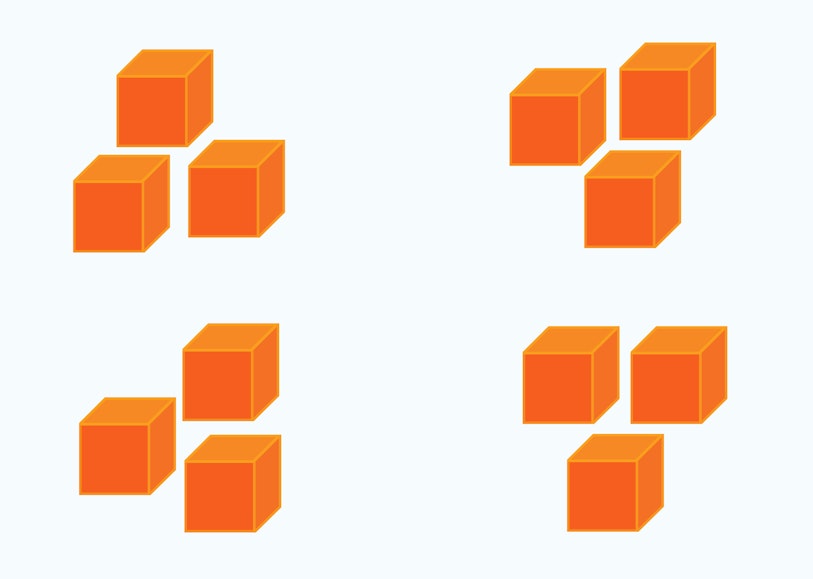
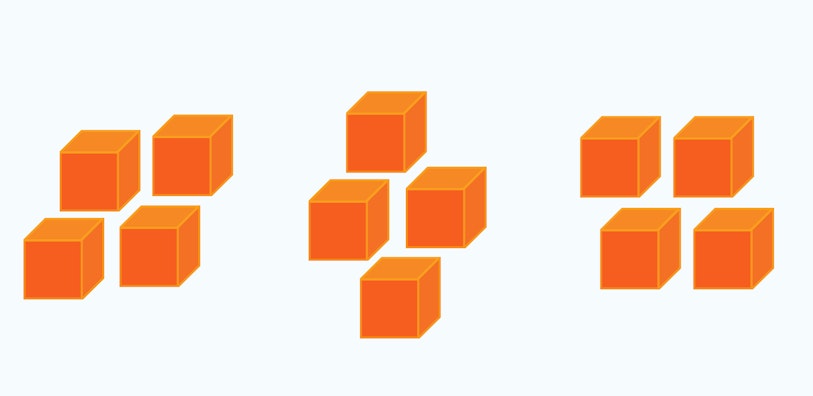
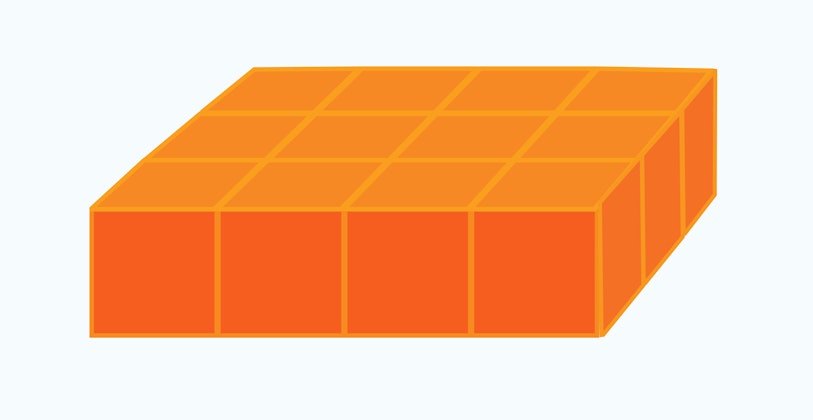
Next, challenge students to find as many ways as possible of forming an array using exactly 12 blocks.
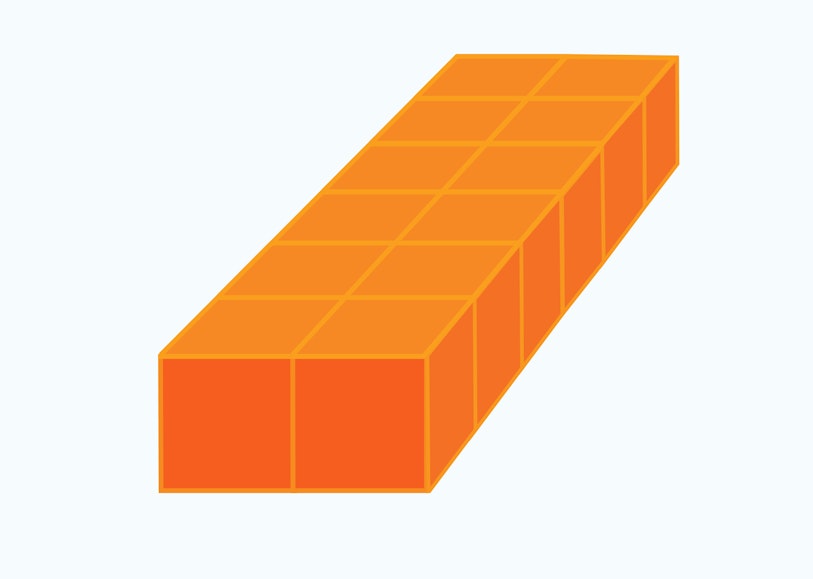

As students begin to find different ways of doing this, emphasise that the side lengths of the different possibilities represent the factors of 12. It is important for students to recognise that 1 is a factor.
You may like to repeat this task using numbers such as 18, 24 or 32.
The purpose of this task is to make the link between the side lengths and the total ‘area’, which students will explore further using grid paper.
It is critical to start with the concrete experiences with the blocks. The arrays can be seen as a ‘picture of the blocks’. The tables that are used later in this stage can be seen as a summary of the picture. Hence, there is a direct link between these three representations, which can be referred to as students move through the stage.
Provide students with some grid paper and ask them to draw an edge around a 13 x 12 grid.
Invite students to share strategies they could use to determine how many squares are in this grid. This provides the opportunity for students to demonstrate their capacity for multiplicative thinking in a variety of ways.
Explain to students that the focus for this task is to consider how we may solve this problem using a visual approach.
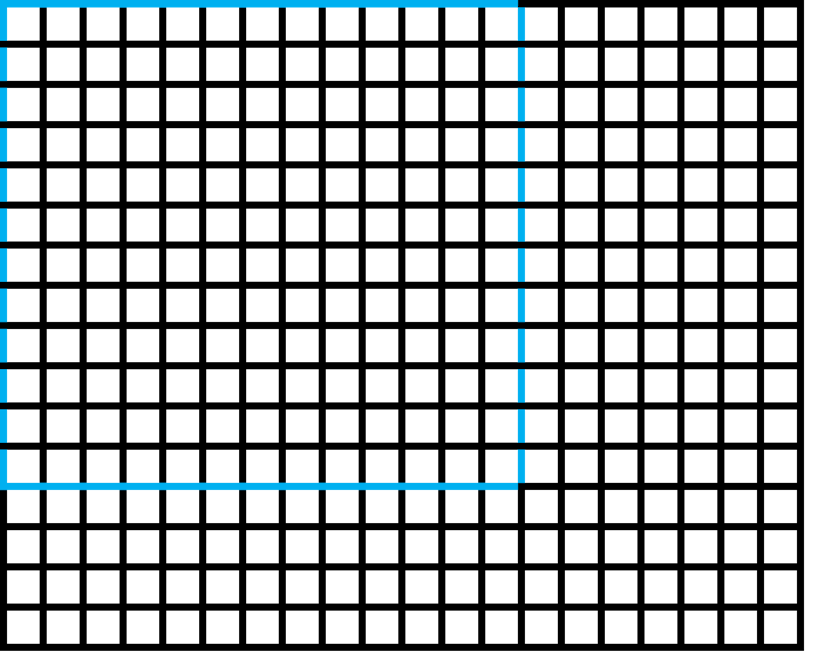
Project the diagram, or reproduce it onto the board, and add the lines in red as in the image below.
Ask students: “Why do you think I placed the red lines there? How might they help work out the answer to 13 x 12?”
Guide students to the recognition that the larger grid has been broken up into four smaller grids and explain how these can be used to find the answer to the original question.
The choice of placing the red line to create a 10 x 10 grid is deliberate, as many students will find multiplication by 10s (or numbers ending with a zero) more accessible.
The larger red grid is 100 squares (10 x 10). The top right grid has 30 squares (10 x 3). The bottom left grid has 20 square (2 x 10). The bottom right grid has 6 squares (2 x 3).
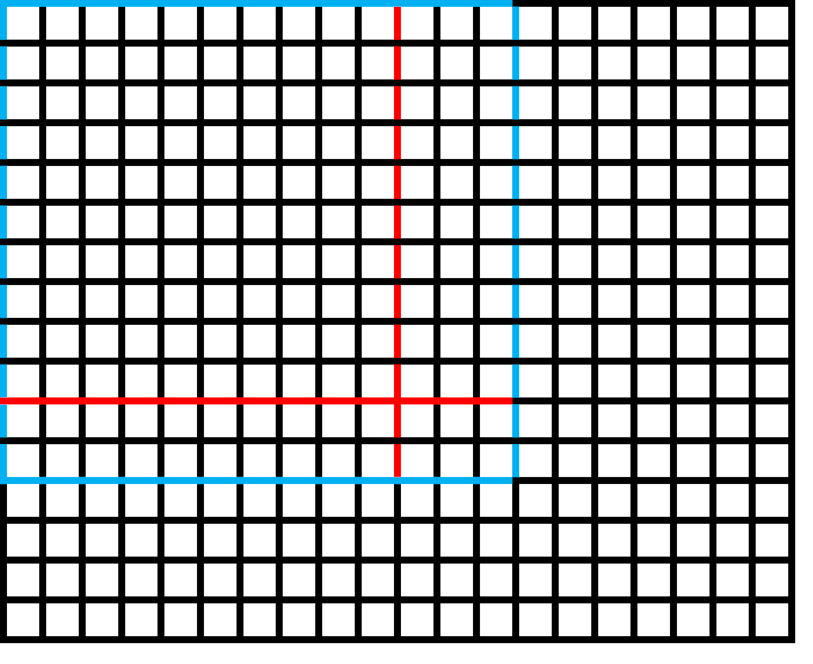
Model how to add 100, 30, 20 and 6 using an open number line to enable students, to demonstrate that the product of 13 x 12 is 156.
Students could use a calculator to verify that this approach successfully finds the correct answer.
Provide students with further opportunities to practice this approach using grid paper, for example 14 x 11, 17 x 13, 19 x 15. Encourage students to find the product using mental addition of each part, or use an open number line.
The repetition of tracing out grids (particularly as they get larger) may inspire some students to independently investigate more efficient ways of solving these problems:
Student: “Do we have to draw up the whole grid each time? Is there a quicker way?”
Teacher: “Maybe… do you have some ideas for how we can do this more efficiently?”
Introduce the use of a table as a summary representation of the grid, and demonstrate how to complete it, using a direct side by side comparison to the grid method.
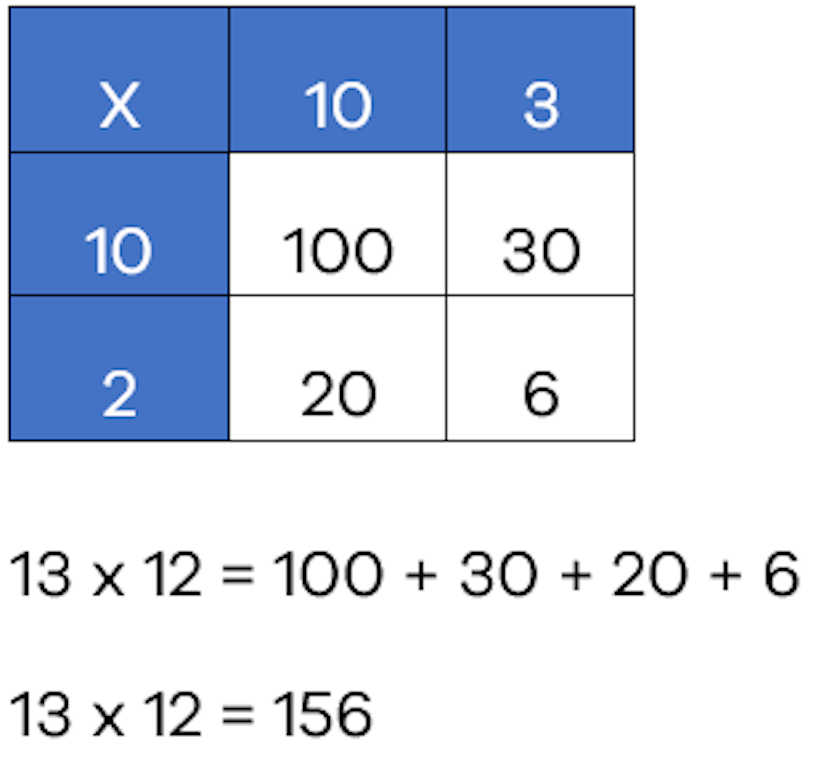
The multiplication can be represented as shown above and annotated with the working underneath. Demonstrate how to find the solution, directly linking it to the grid representation, modelling how to add mentally or using an open number line to find the answer.
The process of breaking up the 13 into 10 and 3, and the 12 into 10 and 2, is called partitioning. It is a useful strategy for students to have at their disposal to break down larger calculations into manageable parts. While you may choose to use partitioning or use analogies such as ‘chunking’ or ‘breaking it up’ to describe the process, ensure that the same term is used by all teachers, so there is consistency of language across the school.
Emphasise the links between this table and the grid diagram presented previously.
Ask students: “How might we use either the grid or table approach to evaluate larger multiplications, such as 24 x 17?”
Students should recognise that the grid to solve this problem would get quite large, but the table could still be readily used to calculate the answer. The examples below show that 24 can be partitioned into either 10, 10 and 4, or 20 and 4, while 17 can be partitioned into 10 and 7:

Enable students to partition using bundling sticks to break down numbers into tens and ones.
Provide students with opportunities to practice these strategies with a range of problems.
Challenge students to investigate how these tables could be used to represent the multiplication of even larger numbers. For example: 236 x 47.
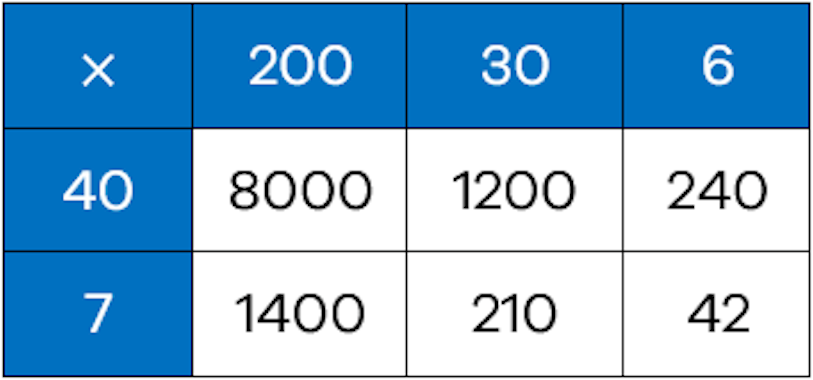
Extend students by altering the tables to introduce a puzzle element. For example, invite students to determine which values could replace the question marks in this table.
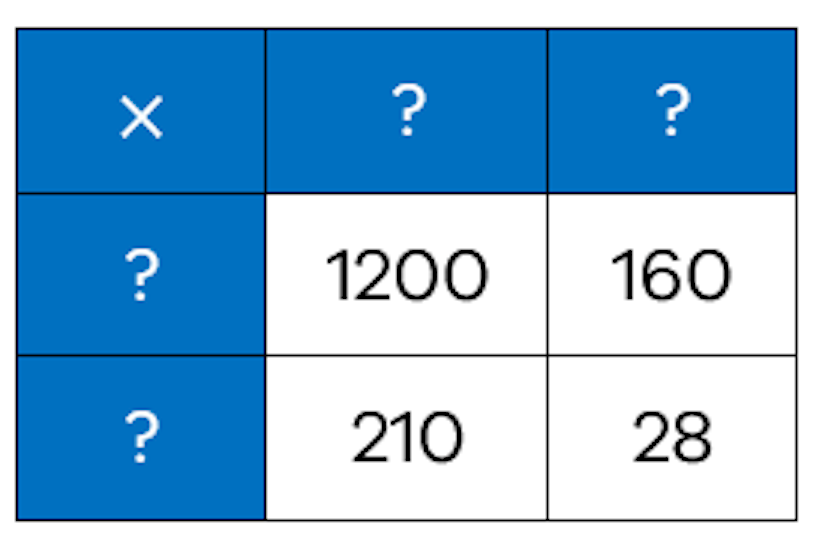
Challenge students to investigate as many ways as possible of completing this table. What are the smallest and largest total products?
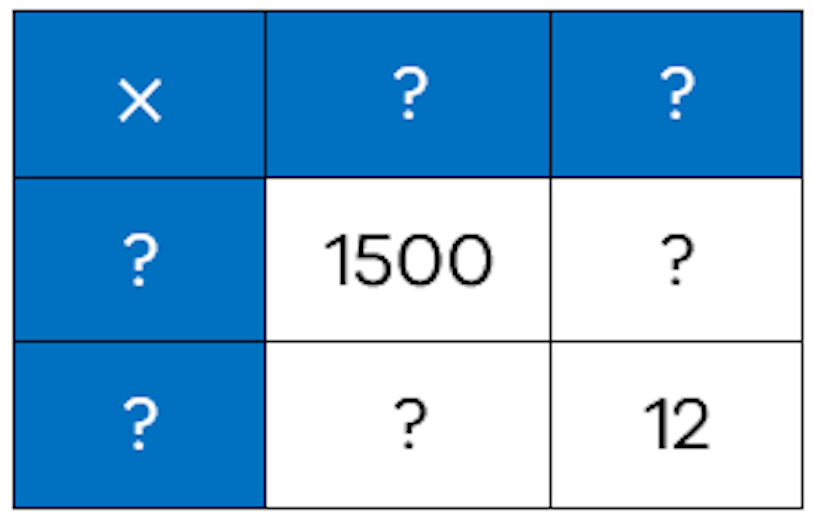
Areas for further exploration
Extend students with the following tasks.
1. Use grids and tables to investigate multiplication of fractions and decimals
Present students with a problem such as 3.5 x 4.5 to solve. Invite students to use the grids and tables to explore the problem.
This visual approach to multiplication can help to address the common misconception that multiplication always makes numbers larger.
The diagram below represents 3.5 x 4.5, partitioned into four rectangles.
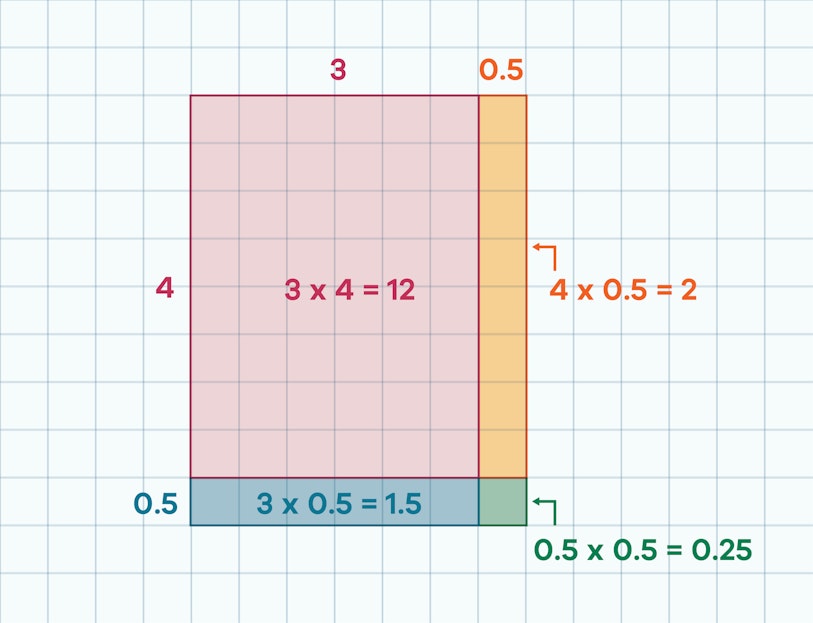
When using this example with your students, identify the four different rectangles that make up 3.5 x 4.5. Show that you have rectangles representing each of the following:
- 3 x 4 = 12
- 4 x 0.5 = 2
- 3 x 0.5 = 1.5
- 0.5 x 0.5 = 0.25 (the small square).
Add them all together to get the answer. Confirm using a calculator.
Draw students’ attention to what happens when you multiply by a fraction. For example, 4 x 0.5 = 2 (which is less than 4). Encourage students to draw it out and manipulate the rectangles to convince themselves that four lots of 0.5 makes 2.
The grid illustrates that the value of 0.5 x 0.5 is equal to 0.25. The unit square which includes where 0.25 is represented can be partitioned into quarters to further demonstrate this.
2. Multiplication using negative numbers
An alternative way of partitioning numbers is to use subtraction, which can then expose students to the concepts of multiplying negative numbers.
For example, the multiplication 18 x 17 could be represented in any of these ways:
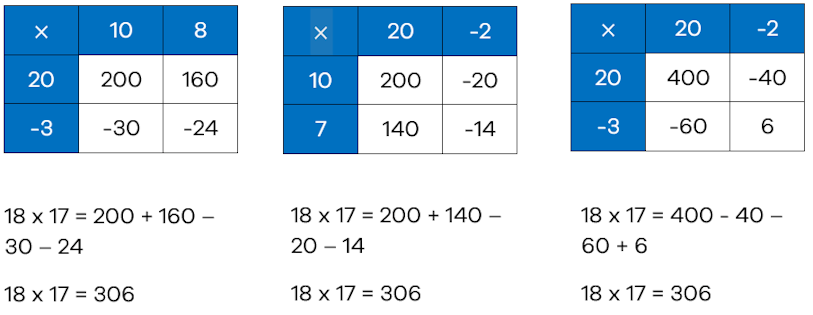
Students may need scaffolding using an open number line to see that partitioning 20 and -2 is equivalent to 10 and 8 (for example). Provide multiple opportunities for students to practice partitioning in this way prior to introducing this technique for multiplication.
Students could be presented with one of the tables above, with only the ‘headings’ filled in, and asked to explore how they could be completed to determine the final answer of 306. This would encourage students to explore multiplication involving negative numbers and to develop their own understanding of this concept.
Later, this could be supported by a discussion around how multiplicative concepts can be extended to negative numbers, rather than students just learning the ‘rules’ related to multiplying (and later dividing) positive and negative numbers. For example, emphasising that 8 x 3 can be thought of as ‘eight groups of three’ and then transferring this thinking to describe 8 x -3 as ‘eight groups of negative three’.
3. Distributive rules used in algebra
While this sequence focusses on Level 6 Number, the approach of using tables to visually represent multiplication could be used to introduce the concept of expanding brackets with algebraic terms, if appropriate for your students.
The following diagrams show how the table approach can be used to expand two different algebraic expressions.
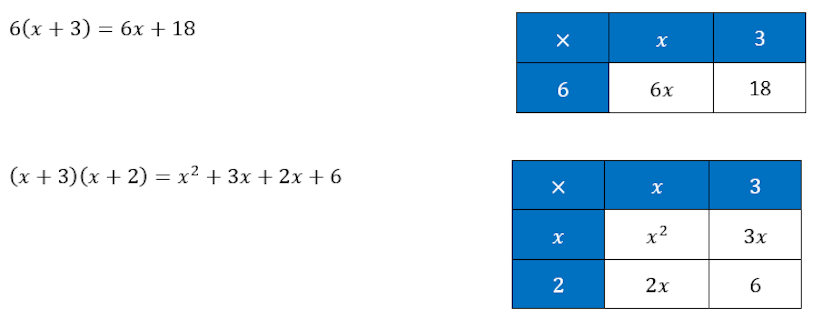
This stage exposes students to a conceptual approach to multiplication using visual prompts, including grids and tables. These methods provide opportunities to consolidate the concepts of factors, areas of rectangles, and multiplication by 10s, 100s and 1000s. Consider the progress made by students when determining which skills and concepts you select to review.
One suggested concept for review is presented below.
1. A range of strategies can be used to solve multiplication problems.
Provide students time to compare these methods of multiplication with any other methods they are familiar with, and to consider the links between various methods.
For example, in the case of 24 x 17, the traditional ‘long multiplication’ algorithm could be demonstrated alongside the table, using colour coding to demonstrate how they correspond with one another:
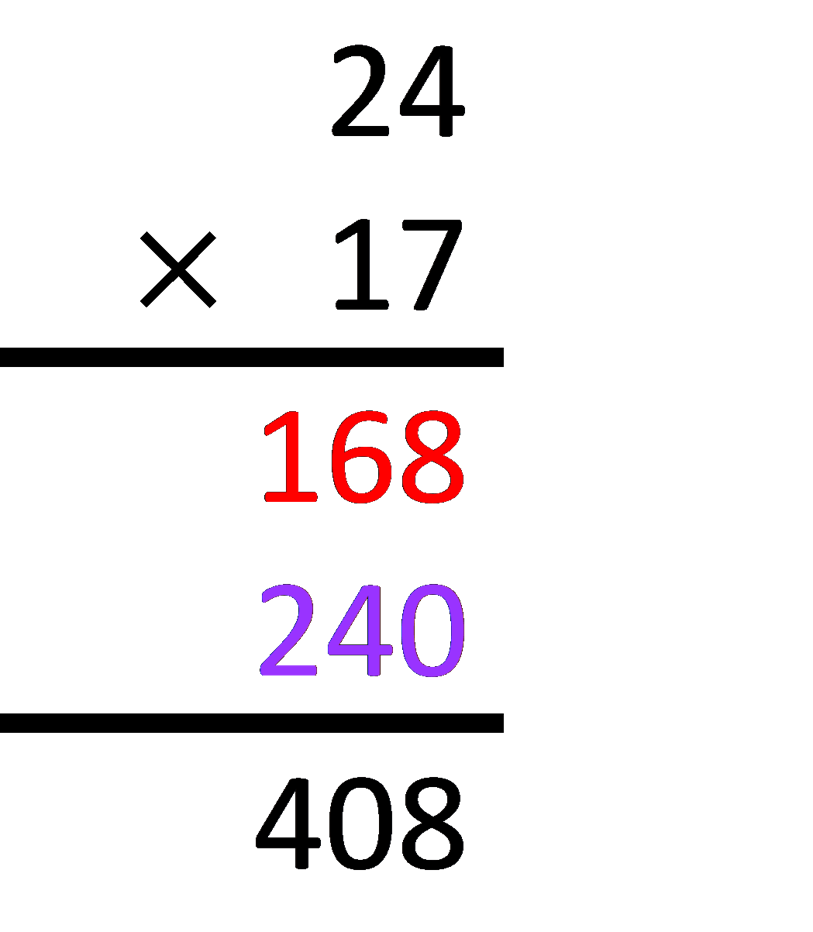
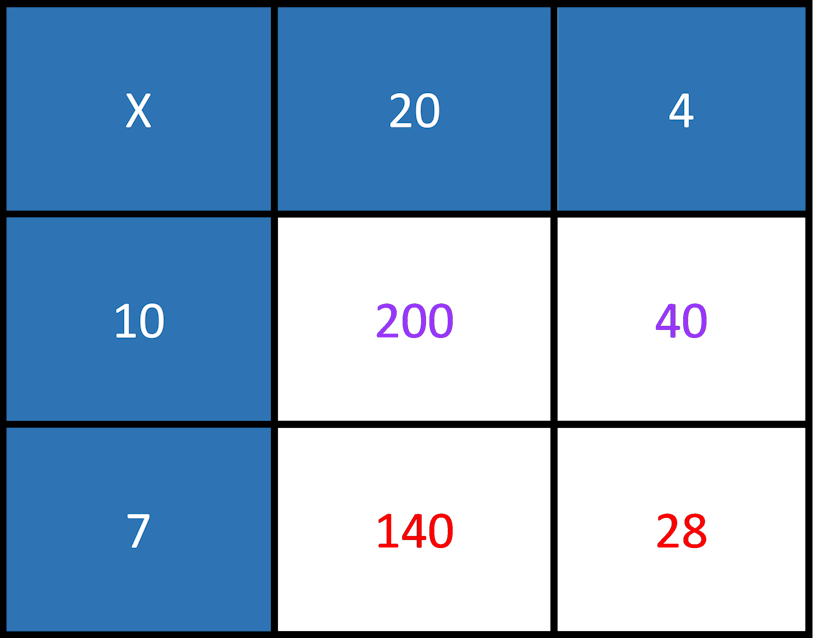
Invite students to contribute any other strategies they are aware of, or use, to solve multiplication problems. There are a great variety of different multiplication techniques developed from around the world. You may like to introduce the Lattice Method as an example of a third strategy that students could be interested in learning about. Students could be invited to compare this with other multiplication strategies, to help them understand and explain why the method works.
To assess for understanding, present students with a range of multiplication problems to choose from and ask them to solve these using a newly learnt strategy. Students could submit their solutions in writing, present their findings to the class or make a short video showing how they solved the problem.
Australian Association of Mathematics Teachers, n.d. Multiplication in a Table Format. [Online]
Available at: maths300.com/members/m300full/162lmult.htm
[Accessed 15 March 2022; Note: access to this resource requires a maths300 subscription].
Wikipedia, 2019. Lattice Multiplication. [Online]
Available at: en.wikipedia.org/wiki/Lattice_multiplication
[Accessed 15 March 2022].
Other stages
2. Liquorice Factory
EXPLORESuggested Learning Intentions
- To develop an understanding and definition of prime numbers
Sample Success Criteria
- I can identify prime numbers and explain why these are prime
- I can use manipulatives to model and explain the properties of prime and composite numbers
3. Daniel's Great Flight
EXPLORESuggested Learning Intentions
- To position and compare positive and negative numbers on a number line
- To develop strategies for adding and subtracting positive and negative numbers
Sample Success Criteria
- I can locate positive and negative numbers on a number line
- I can add and subtract positive and negative numbers
- I can use manipulatives to explain positive and negative numbers
4. Operation Overload
EXPLORESuggested Learning Intentions
- To improve fluency when working with a range of mathematical operations
- To learn how to correctly use different operations to evaluate mathematical statements
Sample Success Criteria
- I can use combinations of operations to create target numbers
- I can use manipulatives to explain and justify my thinking
5. Number Puzzles
EXPLORESuggested Learning Intentions
- To use recognised problem-solving strategies to solve a number puzzle
Sample Success Criteria
- I can select appropriate problem-solving strategies to help me solve a number puzzle
- I can use manipulatives to explain and justify the solutions I have found
6. Number Properties
EXPLORESuggested Learning Intentions
- To explore a range of number properties and use these properties to arrange numbers into sets
- To recognise that some pairs of sets can have common numbers, and some pairs of sets do not have common numbers
Sample Success Criteria
- I can identify properties of numbers
- I can organise numbers into sets with common properties
- I can explain my thinking using manipulatives